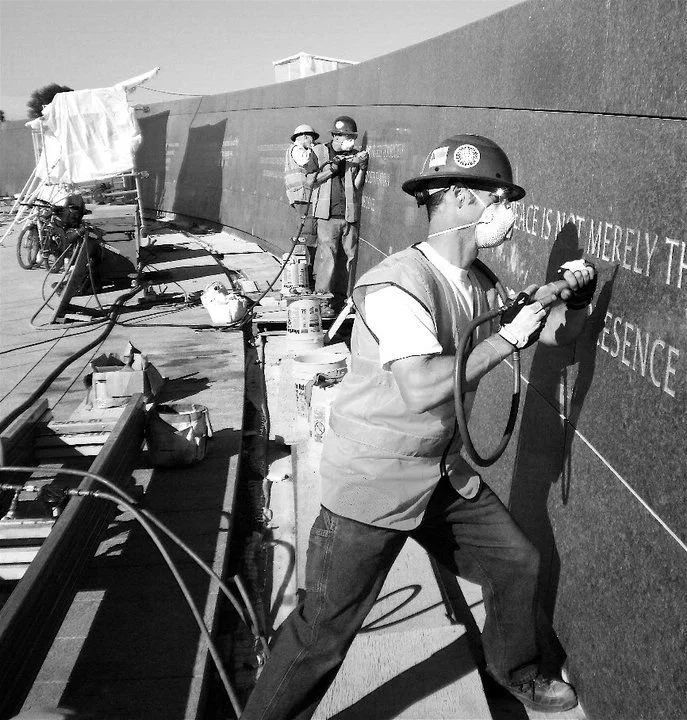August Notes - 2025
LAST OF THE SUMMER EXHIBITIONS : ECHOS OF FORM
Six-artist show exploring the meeting point of science and poetry in visual form.
August 9 - September 14, Echos of Form curated by Nick Benson and Jessica Hagen Fine Art in Newport, Rhode Island. I’ll have new canvases alongside works by Tom Deininger, Nicholas Benson, and others. EXHIBITION INFORMATION
HISTORY SPOTLIGHT: ERIC SCHMIDT, JOHN EVERETT BENSON AND THE FDR MONUMENT
I think it was before I finished graduate school that Eric Schmidt, who had attended Woodstock Country School with me, came to visit from San Francisco, where he was working with Lawrence Halprin’s firm on the FDR Monument. I remember him telling me that FDR’s life was so sprawling and diverse that they needed the monument to read like a story. He drew for me how the monument would run along the edge of the tidal basin, anchoring it in the landscape. When I read that Nick’s father also worked on the monument, I wanted to put them together here. They both passed away recently.
FROM THE LIBRARY: BADDEST MAN THE MAKING OF MIKE TYSON
This one is personal for me. I spent a year and a half in Cus D’Amato’s gym in Catskill, New York, as a sound person for the documentary filmmaker, Michael Marton, when Tyson was 15-16 years old. I drank coffee with Cus and discussed Zen in the Art of Archery by Eugen Herrigel. I ate New York Cheese cake, with Mike on his birthday. We filmed him when he had the fastest knock-out in boxing history - 8 seconds. While waiting between fights at the junior Olympics, we went to Rocky 3. As we walked out to the theater, he said, “If anyone was ever hit as hard as they are in this movie, no one would be a fighter.”
Love him or hate him, this is a stunning account of Mike’s life. Mark Kreigel is a great writer, and of course, I think that because he tracked me down and we spoke for hours about those early years.
From the acclaimed New York Times bestselling author whose coverage of Mike Tyson and his inner circle dates back to the 1980s, a magnificent noir epic about fame, race, greed, criminality, trauma, and the creation of the most feared and mesmerizing fighter in boxing history.
On an evening that defined the "greed is good" 1980s, Donald Trump hosted a raft of celebrities and high rollers in a carnival town on the Jersey Shore to bask in the glow created by a twenty-one-year-old heavyweight champion. Mike Tyson knocked out Michael Spinks that night and in ninety-one frenzied seconds, earned more than the annual payrolls of the Los Angeles Lakers' and Boston Celtics' players combined.
It had been just eight years since Tyson, a feral child from a dystopian Brooklyn neighborhood, was delivered to boxing’s forgotten wizard, Cus D’Amato, who was living a self-imposed exile in upstate New York. Together, Cus and the Kid were an irresistible story of mutual redemption—darlings to the novelists, screenwriters, and newspapermen long charmed by D’Amato, and perfect for the nascent industry of cable television. Way before anyone heard of Tony Soprano, Mike Tyson was HBO’s leading man.
It was the greatest sales job in the sport’s history, and the most lucrative. But the business of Tyson concealed truths that were darker and more nuanced than the script would allow.
The intervening decades have seen Tyson villainized, lionized, and fetishized—but never, until now, fully humanized. Mark Kriegel, an acclaimed biographer regarded as “the finest boxing writer in America,” was a young cityside reporter at the New York Daily News when he was first swept up in the Tyson media hurricane, but here he measures his subject not by whom he knocked out but by what he survived. Though Tyson was billed as a modern-day Jack Dempsey, in truth, he was closer to Sonny Liston: Tyson was Black, feared, and born to die young. What made Liston a pariah, though, would make Tyson—in a way his own handlers could never understand—a touchstone for a generation raised on a soundtrack of hip hop and gunfire.
What Peter Guralnick did for Elvis in Last Train to Memphis and James Kaplan did for Sinatra in Frank, Kriegel does for Tyson. It’s not just the dizzying ascent that he captures but also Tyson’s place in the American psyche.
BLOG POSTS RELATED TO NICHOLAS BENSON







